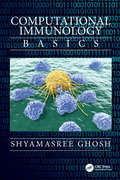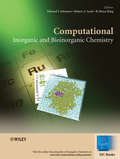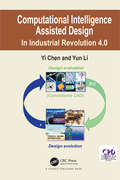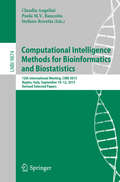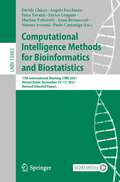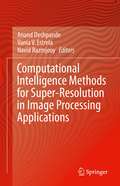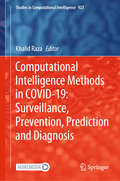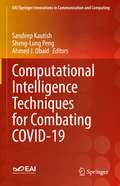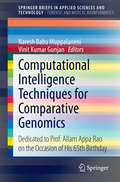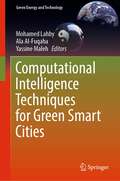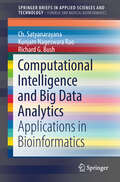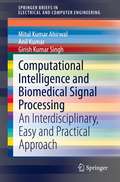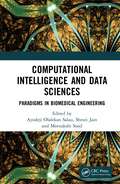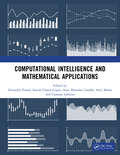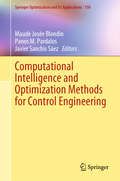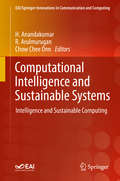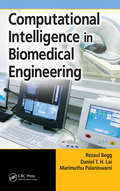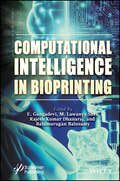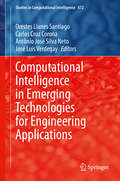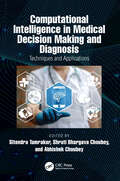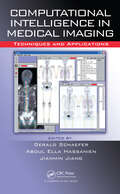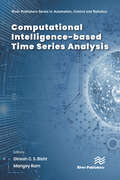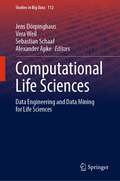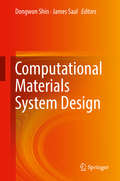- Table View
- List View
Computational Immunology: Basics
by Shyamasree GhoshThe immune system is highly complex system with large number of macromolecules, signaling pathways, protein-protein interactions, and gene expressions. Studies from genomics, transcriptomics, metabolomics are generating huge high throughput data that needs to be analyzed for understanding the Immune system in Health and Disease. Computational approaches arehelping in understanding the study of complex biology of immunology and thereby enabling design of therapeutic strategies in diseases like infectious diseases, immunodeficiency, allergic, hypersensitive, autoimmune disorders and diseases like Cancer, HIV etc. Computational Immunology: Basics highlights the basics of the immune system and function in health and disease. This book offers comprehensive coverage of the most essential topics, including Overview of Immunology and computational Immunology Immune organs and cells, antigen, antibody, B, cell, T cell Antigen Processing and presentation Diseases due to abnormalities of the immune system Cancer Biology Shyamasree Ghosh (MSc, PhD, PGDHE, PGDBI), is currently working in the School of Biological Sciences, National Institute of Science Education and Research (NISER), Bhubaneswar, DAE, Govt of India, graduated from the prestigious Presidency College Kolkata in 1998. She was awarded the prestigious National Scholarship from the Government of India. She has worked and published extensively in glycobiology, sialic acids, immunology, stem cells and nanotechnology. She has authored several publications that include books and encyclopedia chapters in reputed journals and books.
Computational Inorganic and Bioinorganic Chemistry
by Robert A. Scott Edward I. Solomon R. Bruce KingOver the past several decades there have been major advances in our ability to computationally evaluate the electronic structure of inorganic molecules, particularly transition metal systems. This advancement is due to the Moore's Law increase in computing power as well as the impact of density functional theory (DFT) and its implementation in commercial and freeware programs for quantum chemical calculations. Improved pure and hybrid density functionals are allowing DFT calculations with accuracy comparable to high-level Hartree-Fock treatments, and the results of these calculations can now be evaluated by experiment.When calculations are correlated to, and supported by, experimental data they can provide fundamental insight into electronic structure and its contributions to physical properties and chemical reactivity. This interplay continues to expand and contributes to both improved value of experimental results and improved accuracy of computational predictions.The purpose of this EIC Book is to provide state-of-the-art presentations of quantum mechanical and related methods and their applications, written by many of the leaders in the field. Part 1 of this volume focuses on methods, their background and implementation, and their use in describing bonding properties, energies, transition states and spectroscopic features. Part 2 focuses on applications in bioinorganic chemistry and Part 3 discusses inorganic chemistry, where electronic structure calculations have already had a major impact. This addition to the EIC Book series is of significant value to both experimentalists and theoreticians, and we anticipate that it will stimulate both further development of the methodology and its applications in the many interdisciplinary fields that comprise modern inorganic and bioinorganic chemistry.This volume is also available as part of Encyclopedia of Inorganic Chemistry, 5 Volume Set.This set combines all volumes published as EIC Books from 2007 to 2010, representing areas of key developments in the field of inorganic chemistry published in the Encyclopedia of Inorganic Chemistry. Find out more.
Computational Intelligence Aided Systems for Healthcare Domain
by Akshansh GuptaThis book covers recent advances in artificial intelligence, smart computing, and their applications in augmenting medical and health care systems. It will serve as an ideal reference text for graduate students and academic researchers in diverse engineering fields including electrical, electronics and communication, computer, and biomedical. This book- Presents architecture, characteristics, and applications of artificial intelligence and smart computing in health care systems. Highlights privacy issues faced in health care and health informatics using artificial intelligence and smart computing technologies. Discusses nature-inspired computing algorithms for the brain-computer interface. Covers graph neural network application in the medical domain. Provides insights into the state-of-the-art artificial intelligence and smart computing enabling and emerging technologies. This book discusses recent advances and applications of artificial intelligence and smart technologies in the field of healthcare. It highlights privacy issues faced in health care and health informatics using artificial intelligence and smart computing technologies. It covers nature-inspired computing algorithms such as genetic algorithms, particle swarm optimization algorithms, and common scrambling algorithms to study brain-computer interfaces. It will serve as an ideal reference text for graduate students and academic researchers in the fields of electrical engineering, electronics and communication engineering, computer engineering, and biomedical engineering.
Computational Intelligence Assisted Design: In Industrial Revolution 4.0
by Yun Li Yi ChenComputational Intelligence Assisted Design framework mobilises computational resources, makes use of multiple Computational Intelligence (CI) algorithms and reduces computational costs. This book provides examples of real-world applications of technology. Case studies have been used to show the integration of services, cloud, big data technology and space missions. It focuses on computational modelling of biological and natural intelligent systems, encompassing swarm intelligence, fuzzy systems, artificial neutral networks, artificial immune systems and evolutionary computation. This book provides readers with wide-scale information on CI paradigms and algorithms, inviting readers to implement and problem solve real-world, complex problems within the CI development framework. This implementation framework will enable readers to tackle new problems without difficulty through a few tested MATLAB source codes
Computational Intelligence Methods for Bioinformatics and Biostatistics: 12th International Meeting, CIBB 2015, Naples, Italy, September 10-12, 2015, Revised Selected Papers (Lecture Notes in Computer Science #9874)
by Stefano Rovetta Claudia Angelini Paola M. V. RancoitaThis book constitutes the thoroughly refereed post-conference proceedings of the 12th International Meeting on Computational Intelligence Methods for Bioinformatics and Biostatistics, CIBB 2015, held in Naples, Italy, in September, 2015. The 21 revised full papers presented were carefully reviewed and selected from 24 submissions. They present problems concerning computational techniques in bioinformatics, systems biology and medical informatics discussing cutting edge methodologies and accelerate life science discoveries, as well as novel challenges with an high impact on molecular biology and translational medicine.
Computational Intelligence Methods for Bioinformatics and Biostatistics: 17th International Meeting, CIBB 2021, Virtual Event, November 15–17, 2021, Revised Selected Papers (Lecture Notes in Computer Science #13483)
by Paolo Cazzaniga Davide Chicco Angelo Facchiano Erica Tavazzi Enrico Longato Martina Vettoretti Anna Bernasconi Simone AvesaniThis book constitutes revised selected papers from the 17th International Meeting on Computational Intelligence Methods for Bioinformatics and Biostatistics, CIBB 2021, which was held virtually during November 15–17, 2021. The 19 papers included in these proceedings were carefully reviewed and selected from 26 submissions, and they focus on bioinformatics, computational biology, health informatics, cheminformatics, biotechnology, biostatistics, and biomedical imaging.
Computational Intelligence Methods for Super-Resolution in Image Processing Applications
by Anand Deshpande Navid Razmjooy Vania V. EstrelaThis book explores the application of deep learning techniques within a particularly difficult computational type of computer vision (CV) problem ─ super-resolution (SR). The authors present and discuss ways to apply computational intelligence (CI) methods to SR. The volume also explores the possibility of using different kinds of CV techniques to develop and enhance the tools/processes related to SR. The application areas covered include biomedical engineering, healthcare applications, medicine, histology, and material science. The book will be a valuable reference for anyone concerned with multiple multimodal images, especially professionals working in remote sensing, nanotechnology and immunology at research institutes, healthcare facilities, biotechnology institutions, agribusiness services, veterinary facilities, and universities.
Computational Intelligence Methods in COVID-19: Surveillance, Prevention, Prediction and Diagnosis (Studies in Computational Intelligence #923)
by Khalid RazaThe novel coronavirus disease 2019 (COVID-19) pandemic has posed a major threat to human life and health. This book is beneficial for interdisciplinary students, researchers, and professionals to understand COVID-19 and how computational intelligence can be used for the purpose of surveillance, control, prevention, prediction, diagnosis, and potential treatment of the disease. The book contains different aspects of COVID-19 that includes fundamental knowledge, epidemic forecast models, surveillance and tracking systems, IoT- and IoMT-based integrated systems for COVID-19, social network analysis systems for COVID-19, radiological images (CT, X-ray) based diagnosis system, and computational intelligence and in silico drug design and drug repurposing methods against COVID-19 patients. The contributing authors of this volume are experts in their fields and they are from various reputed universities and institutions across the world. This volume is a valuable and comprehensive resource for computer and data scientists, epidemiologists, radiologists, doctors, clinicians, pharmaceutical professionals, along with graduate and research students of interdisciplinary and multidisciplinary sciences.
Computational Intelligence Techniques for Combating COVID-19 (EAI/Springer Innovations in Communication and Computing)
by Sheng-Lung Peng Sandeep Kautish Ahmed J. ObaidThis book presents the latest cutting edge research, theoretical methods, and novel applications in the field of computational intelligence and computational biological approaches that are aiming to combat COVID-19. The book gives the technological key drivers behind using AI to find drugs that target the virus, shedding light on the structure of COVID-19, detecting the outbreak and spread of new diseases, spotting signs of a COVID-19 infection in medical images, monitoring how the virus and lockdown is affecting mental health, and forecasting how COVID-19 cases and deaths will spread across cities and why. Further, the book helps readers understand computational intelligence techniques combating COVID-19 in a simple and systematic way.
Computational Intelligence Techniques for Comparative Genomics: Dedicated to Prof. Allam Appa Rao on the Occasion of His 65th Birthday (SpringerBriefs in Applied Sciences and Technology)
by Vinit Kumar Gunjan Naresh Babu MuppalaneniThis Brief highlights Informatics and related techniques to Computer Science Professionals, Engineers, Medical Doctors, Bioinformatics researchers and other interdisciplinary researchers. Chapters include the Bioinformatics of Diabetes and several computational algorithms and statistical analysis approach to effectively study the disorders and possible causes along with medical applications.
Computational Intelligence Techniques for Green Smart Cities (Green Energy and Technology)
by Ala Al-Fuqaha Yassine Maleh Mohamed LahbyThis book contains high-quality and original research on computational intelligence for green smart cities research. In recent years, the use of smart city technology has rapidly increased through the successful development and deployment of Internet of Things (IoT) architectures. The citizens' quality of life has been improved in several sensitive areas of the city, such as transportation, buildings, health care, education, environment, and security, thanks to these technological advancesComputational intelligence techniques and algorithms enable a computational analysis of enormous data sets to reveal patterns that recur. This information is used to inform and improve decision-making at the municipal level to build smart computational intelligence techniques and sustainable cities for their citizens. Machine intelligence allows us to identify trends (patterns). The smart city could better integrate its transportation network, for example. By offering a better public transportation network adapted to the demand, we could reduce personal vehicles and energy consumption. A smart city could use models to predict the consequences of a change, such as pedestrianizing a street or adding a bike lane. A city can even create a 3D digital twin to test hypothetical projects. This book comprises many state-of-the-art contributions from scientists and practitioners working in machine intelligence and green smart cities. It aspires to provide a relevant reference for students, researchers, engineers, and professionals working in this area or those interested in grasping its diverse facets and exploring the latest advances in machine intelligence for green and sustainable smart city applications.
Computational Intelligence and Big Data Analytics: Applications in Bioinformatics (SpringerBriefs in Applied Sciences and Technology)
by Ch. Satyanarayana Kunjam Nageswara Rao Richard G. BushThis book highlights major issues related to big data analysis using computational intelligence techniques, mostly interdisciplinary in nature. It comprises chapters on computational intelligence technologies, such as neural networks and learning algorithms, evolutionary computation, fuzzy systems and other emerging techniques in data science and big data, ranging from methodologies, theory and algorithms for handling big data, to their applications in bioinformatics and related disciplines. The book describes the latest solutions, scientific results and methods in solving intriguing problems in the fields of big data analytics, intelligent agents and computational intelligence. It reflects the state of the art research in the field and novel applications of new processing techniques in computer science. This book is useful to both doctoral students and researchers from computer science and engineering fields and bioinformatics related domains.
Computational Intelligence and Biomedical Signal Processing: An Interdisciplinary, Easy and Practical Approach (SpringerBriefs in Electrical and Computer Engineering)
by Anil Kumar Mitul Kumar Ahirwal Girish Kumar SinghThis book presents an interdisciplinary paradigms of computational intelligence techniques and biomedical signal processing. The computational intelligence techniques outlined in the book will help to develop various ways to enhance and utilize signal processing algorithms in the field of biomedical signal processing. In this book, authors have discussed research, discoveries and innovations in computational intelligence, signal processing, and biomedical engineering that will be beneficial to engineers working in the field of health care systems. The book provides fundamental and initial level theory and implementation tools, so that readers can quickly start their research in these interdisciplinary domains.
Computational Intelligence and Data Sciences: Paradigms in Biomedical Engineering
by Ayodeji Olalekan Salau, Shruti Jain, Meenakshi SoodThis book presents futuristic trends in computational intelligence including algorithms as applicable to different application domains in health informatics covering bio-medical, bioinformatics, and biological sciences. Latest evolutionary approaches to solve optimization problems under biomedical engineering field are discussed. It provides conceptual framework with a focus on application of computational intelligence techniques in the domain of biomedical engineering and health informatics including real-time issues.
Computational Intelligence and Mathematical Applications: Proceedings of the International Conference on Computational Intelligence and Mathematical Applications
by Devendra Prasad Suresh Chand Gupta Anju Bhandari Gandhi Stuti Mehla Upasana LakhinaIt is with great pleasure to present the proceedings of the International Conference on Computational Intelligence and Mathematical Applications (ICCIMA 2023), held on 21-22 December 2023, at Panipat Institute of Engineering and Technology, Panipat. This conference brought scholars, researchers, professionals, and intellectuals together from diverse fields to exchange ideas, share insights, and foster collaborations in Optimization, Computational Intelligence and Mathematical Applications. The ICCIMA 2023 served as a platform for contributors to demonstrate their latest findings, discuss emerging trends, and explore innovations to the problems that different disciplines are currently experiencing. The conference’s scope and depth of themes reflect our community’s rich diversity of interests and levels of competence.
Computational Intelligence and Optimization Methods for Control Engineering (Springer Optimization and Its Applications #150)
by Panos M. Pardalos Maude Josée Blondin Javier Sanchis SáezThis volume presents some recent and principal developments related to computational intelligence and optimization methods in control. Theoretical aspects and practical applications of control engineering are covered by 14 self-contained contributions. Additional gems include the discussion of future directions and research perspectives designed to add to the reader’s understanding of both the challenges faced in control engineering and the insights into the developing of new techniques. With the knowledge obtained, readers are encouraged to determine the appropriate control method for specific applications.
Computational Intelligence and Sustainable Systems: Intelligence and Sustainable Computing (EAI/Springer Innovations in Communication and Computing)
by H. Anandakumar R. Arulmurugan Chow Chee OnnThis book features research related to computational intelligence and energy and thermal aware management of computing resources. The authors publish original and timely research in current areas of power, energy, temperature, and environmental engineering as and advances in computational intelligence that are benefiting the fields. Topics include signal processing architectures, algorithms, and applications; biomedical informatics and computation; artificial intelligence and machine learning; green technologies in information; and more. The book includes contributions from a wide range of researchers, academicians, and industry professionals. The book is made up both of extended papers presented at the International Conference on Intelligent Computing and Sustainable System (ICICSS 2018), September 20-21, 2018, and other accepted papers on R&D and original research work related to the practice and theory of technologies to enable and support Intelligent Computing applications.
Computational Intelligence in Biomedical Engineering
by Marimuthu Palaniswami Rezaul Begg Daniel T.H. LaiAs in many other fields, biomedical engineers benefit from the use of computational intelligence (CI) tools to solve complex and non-linear problems. The benefits could be even greater if there were scientific literature that specifically focused on the biomedical applications of computational intelligence techniques. The first comprehensive field-
Computational Intelligence in Bioprinting: Challenges and Future Directions
by Balamurugan Balusamy Rajesh Kumar Dhanaraj M. Lawanya Shri E. GangadeviCOMPUTATIONAL INTELLIGENCE IN BIOPRINTING The book provides a comprehensive exploration of the evolving field of bioprinting in regenerative medicine and is an essential guide for professionals seeking a thorough understanding of the field. Computational Intelligence in Bioprinting provides a comprehensive overview of the evolving field of bioprinting in reformative medicine, defining the process of printing structures using viable cells, biomaterials, and living molecules. The primary goal is to provide substitutes for tissue implants, which might lead to eliminating the requirement for organ donors, as well as to transform animal testing for the learning and analysis of disease and the growth of treatments. The book offers a comprehensive overview of bioprinting technologies and their applications, emphasizing the integration of computation intelligence, artificial intelligence, and other computer science advancements in the field. By harnessing the power of computational intelligence techniques such as AI, machine learning, optimization algorithms, and data analytics, existing hurdles can be overcome and the full potential of bioprinting can be unlocked. The book covers an extensive range of topics, including bio-ink formulation and characterization, bioprinter hardware and software design, tissue and organ modeling, image analysis, process optimization, and quality control. Audience The book is aimed at professionals, practitioners and researchers in the fields of bioprinting, tissue engineering, and computational intelligence in medicine.
Computational Intelligence in Emerging Technologies for Engineering Applications (Studies in Computational Intelligence #872)
by Orestes Llanes Santiago José Luis Verdegay Carlos Cruz Corona Antônio José Silva NetoThis book explores applications of computational intelligence in key and emerging fields of engineering, especially with regard to condition monitoring and fault diagnosis, inverse problems, decision support systems and optimization. These applications can be beneficial in a broad range of contexts, including: water distribution networks, manufacturing systems, production and storage of electrical energy, heat transfer, acoustic levitation, uncertainty and robustness of infinite-dimensional objects, fatigue failure prediction, autonomous navigation, nanotechnology, and the analysis of technological development indexes. All applications, mathematical and computational tools, and original results are presented using rigorous mathematical procedures. Further, the book gathers contributions by respected experts from 22 different research centers and eight countries: Brazil, Cuba, France, Hungary, India, Japan, Romania and Spain. The book is intended for use in graduate courses on applied computation, applied mathematics, and engineering, where tools like computational intelligence and numerical methods are applied to the solution of real-world problems in emerging areas of engineering.
Computational Intelligence in Medical Decision Making and Diagnosis: Techniques and Applications (Computational Intelligence Techniques)
by Sitendra Tamrakar Shruti Bhargava Choubey Abhishek ChoubeyComputation intelligence (CI) paradigms, including artificial neural networks, fuzzy systems, evolutionary computing techniques, and intelligent agents, form the basis of making clinical decisions. This book explains different aspects of the current research on CI technologies applied in the field of medical diagnosis. It discusses critical issues related to medical diagnosis, like uncertainties in the medical domain, problems in the medical data, especially dealing with time-stamped data, and knowledge acquisition. Features: Introduces recent applications of new computational intelligence technologies focusing on medical diagnosis issues. Reviews multidisciplinary research in health care, like data mining, medical imaging, pattern recognition, and so forth. Explores intelligent systems and applications of learning in health-care challenges, along with the representation and reasoning of clinical uncertainty. Addresses problems resulting from automated data collection in modern hospitals, with possible solutions to support medical decision-making systems. Discusses current and emerging intelligent systems with respect to evolutionary computation and its applications in the medical domain. This book is aimed at researchers, professionals, and graduate students in computational intelligence, signal processing, imaging, artificial intelligence, and data analytics.
Computational Intelligence in Medical Imaging: Techniques and Applications
by Gerald Schaefer Aboul Ella Hassanien Jianmin JiangCI Techniques & Algorithms for a Variety of Medical Imaging SituationsDocuments recent advances and stimulates further researchA compilation of the latest trends in the field, Computational Intelligence in Medical Imaging: Techniques and Applications explores how intelligent computing can bring enormous benefit to existing technology in medical
Computational Intelligence-based Time Series Analysis (River Publishers Series In Automation, Control, And Robotics Is A Series Of Comprehensive Academic And Professional Books Which Focus On The Theory And Applications Of Automation, Control And Robotics. The Series Focuses On Topics Ranging From The Theory And Use Of Control Systems, Automation Engineering, Robotics And Intelligent Machines. Books Published In The Series Include Research Monographs,)
by Mangey Ram Dinesh C. S. BishtThe sequential analysis of data and information gathered from past to present is called time series analysis. Time series data are of high dimension, large size and updated continuously. A time series depends on various factors like trend, seasonality, cycle and irregular data set, and is basically a series of data points well-organized in time. Time series forecasting is a significant area of machine learning. There are various prediction problems that are time-dependent and these problems can be handled through time series analysis. Computational intelligence (CI) is a developing computing approach for the forthcoming several years. CI gives the litheness to model the problem according to given requirements. It helps to find swift solutions to the problems arising in numerous disciplines. These methods mimic human behavior. The main objective of CI is to develop intelligent machines to provide solutions to real world problems, which are not modelled or are too difficult to model mathematically. This book aims to cover the recent advances in time series and applications of CI for time series analysis.
Computational Life Sciences: Data Engineering and Data Mining for Life Sciences (Studies in Big Data #112)
by Jens Dörpinghaus Vera Weil Sebastian Schaaf Alexander ApkeThis book broadly covers the given spectrum of disciplines in Computational Life Sciences, transforming it into a strong helping hand for teachers, students, practitioners and researchers. In Life Sciences, problem-solving and data analysis often depend on biological expertise combined with technical skills in order to generate, manage and efficiently analyse big data. These technical skills can easily be enhanced by good theoretical foundations, developed from well-chosen practical examples and inspiring new strategies. This is the innovative approach of Computational Life Sciences-Data Engineering and Data Mining for Life Sciences: We present basic concepts, advanced topics and emerging technologies, introduce algorithm design and programming principles, address data mining and knowledge discovery as well as applications arising from real projects. Chapters are largely independent and often flanked by illustrative examples and practical advise.
Computational Materials System Design
by Dongwon Shin James SaalThis book provides state-of-the-art computational approaches for accelerating materials discovery, synthesis, and processing using thermodynamics and kinetics. The authors deliver an overview of current practical computational tools for materials design in the field. They describe ways to integrate thermodynamics and kinetics and how the two can supplement each other.
